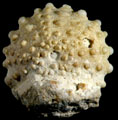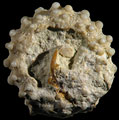The spine canopy of Acropeltis was described by Roman et al. (1991) and is very similar to that seen in the modern Colobocentrotus. As argued by those authors, this taxon was presumably adapted for life in highly turbulent rocky coastal environments. Acrocidaris has a similar tuberculation, but its ambulacra are polygeminate, its tubercles perforate and its plating diadematid. Distinguished from all other acropeltidae by its single large primary tubercle on each genital plate.
Agassiz, L. 1838. Monographies d'Échinodermes vivants et fossiles. Première monographie: Des Salénies. Petitpierre, Neuchâtel, 32 pp., 5 pls.
Mortensen, T. 1935. A monograph of the Echinoidea II. Bothriocidaroida, Melonechinoida, Lepidocentroida and Stirodonta. C. A. Reitzel, Copenhagen.
Roman, J., Vadet, A. & Boullier, 1991. Echinoides et brachiopodes de la limite Jurassique-Cretace a Canjuers (Var, France). Revue de Paleobiologie 10, 21-27.




